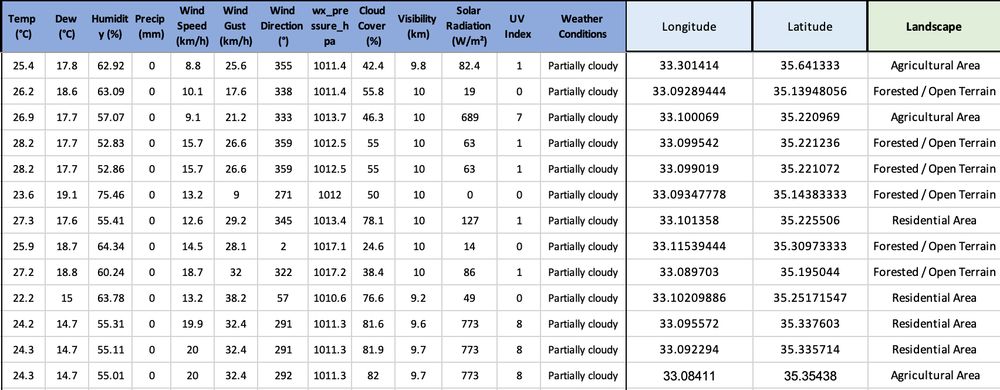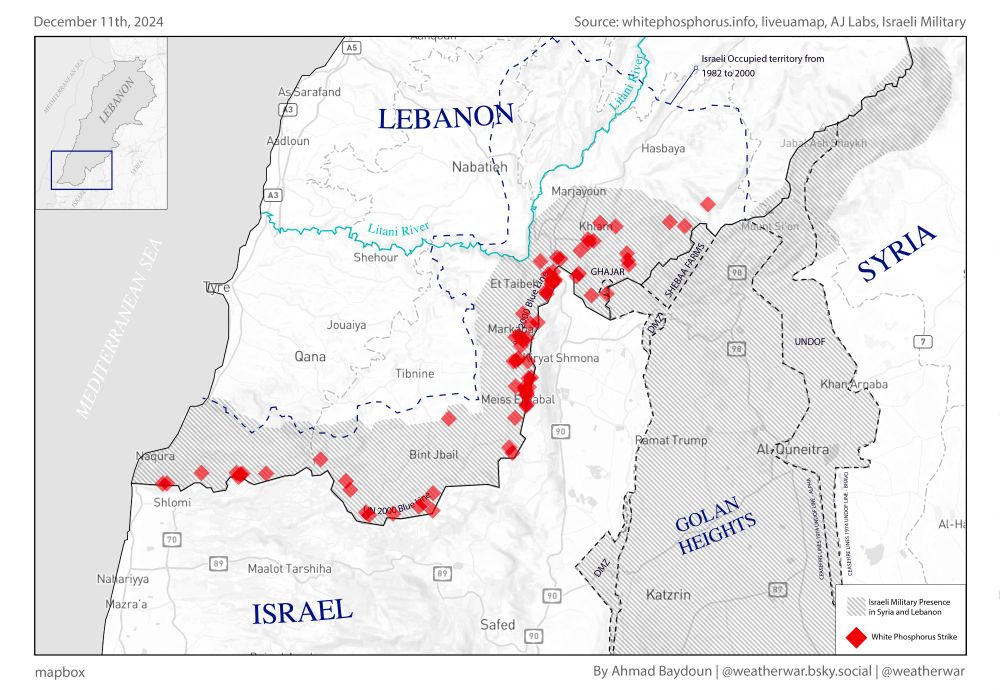
WhitePhosphorus.info
@whitephosphorus.info
A spatial archive of 248 verified and geolocated white phosphorus strikes across South Lebanon (2023–2024). Explore the archive on: whitephosphorus.info
Developed as part of the PhD research of @baydoun.nl
Developed as part of the PhD research of @baydoun.nl
Sometimes the same white phosphorus strike was captured from different cameras and angles. In some cases even from across the Israel–Lebanon border, as with WP100 shown here.
This makes geolocating each photographer’s point of view important to avoid double counting.
This makes geolocating each photographer’s point of view important to avoid double counting.

November 11, 2025 at 3:43 PM
Sometimes the same white phosphorus strike was captured from different cameras and angles. In some cases even from across the Israel–Lebanon border, as with WP100 shown here.
This makes geolocating each photographer’s point of view important to avoid double counting.
This makes geolocating each photographer’s point of view important to avoid double counting.
Access to daily satellite imagery significantly helped in geolocating, chronolocating, and assessing the burn marks of each strike.
In some cases, no visible trace remained, especially under humid conditions or within urban areas.
(Imagery shown of WP112 from Planet Labs)
In some cases, no visible trace remained, especially under humid conditions or within urban areas.
(Imagery shown of WP112 from Planet Labs)
November 11, 2025 at 3:42 PM
Access to daily satellite imagery significantly helped in geolocating, chronolocating, and assessing the burn marks of each strike.
In some cases, no visible trace remained, especially under humid conditions or within urban areas.
(Imagery shown of WP112 from Planet Labs)
In some cases, no visible trace remained, especially under humid conditions or within urban areas.
(Imagery shown of WP112 from Planet Labs)
Weather analysis (data from Visual Crossing) reveals a clear operational pattern.
95% of strikes occurred under clear skies, and over 90% during southerly winds from Israel into Lebanon.
Dry conditions and southerly winds maximized plume drift northward and increased fire risk.
95% of strikes occurred under clear skies, and over 90% during southerly winds from Israel into Lebanon.
Dry conditions and southerly winds maximized plume drift northward and increased fire risk.

November 11, 2025 at 3:41 PM
Weather analysis (data from Visual Crossing) reveals a clear operational pattern.
95% of strikes occurred under clear skies, and over 90% during southerly winds from Israel into Lebanon.
Dry conditions and southerly winds maximized plume drift northward and increased fire risk.
95% of strikes occurred under clear skies, and over 90% during southerly winds from Israel into Lebanon.
Dry conditions and southerly winds maximized plume drift northward and increased fire risk.
The IDF says white phosphorus was used for camouflage and smokescreens.
Yet 91% of the strikes occurred before Israel’s ground invasion in October 2024; deep inside Lebanon, far from any troop presence.
Its timing and location suggest a use unrelated to battlefield concealment.
Yet 91% of the strikes occurred before Israel’s ground invasion in October 2024; deep inside Lebanon, far from any troop presence.
Its timing and location suggest a use unrelated to battlefield concealment.
November 11, 2025 at 3:40 PM
The IDF says white phosphorus was used for camouflage and smokescreens.
Yet 91% of the strikes occurred before Israel’s ground invasion in October 2024; deep inside Lebanon, far from any troop presence.
Its timing and location suggest a use unrelated to battlefield concealment.
Yet 91% of the strikes occurred before Israel’s ground invasion in October 2024; deep inside Lebanon, far from any troop presence.
Its timing and location suggest a use unrelated to battlefield concealment.
The IDF claims white phosphorus shells “are not used in densely populated areas, with certain exceptions.”
Yet 39% of strikes hit residential areas and 17% struck agricultural land.
The remaining 44% struck forested or open terrain, possibly intended to clear vegetation.
Yet 39% of strikes hit residential areas and 17% struck agricultural land.
The remaining 44% struck forested or open terrain, possibly intended to clear vegetation.
November 11, 2025 at 3:40 PM
The IDF claims white phosphorus shells “are not used in densely populated areas, with certain exceptions.”
Yet 39% of strikes hit residential areas and 17% struck agricultural land.
The remaining 44% struck forested or open terrain, possibly intended to clear vegetation.
Yet 39% of strikes hit residential areas and 17% struck agricultural land.
The remaining 44% struck forested or open terrain, possibly intended to clear vegetation.
NEW: We’ve added 53 more white phosphorus strikes to our archive whitephosphorus.info, bringing the total to 248 verified and geolocated incidents across South #Lebanon (2023–2024).
The IDF says these were used as smokescreens, away from civilians.
Our findings show otherwise. 🧵
The IDF says these were used as smokescreens, away from civilians.
Our findings show otherwise. 🧵
November 11, 2025 at 3:38 PM
NEW: We’ve added 53 more white phosphorus strikes to our archive whitephosphorus.info, bringing the total to 248 verified and geolocated incidents across South #Lebanon (2023–2024).
The IDF says these were used as smokescreens, away from civilians.
Our findings show otherwise. 🧵
The IDF says these were used as smokescreens, away from civilians.
Our findings show otherwise. 🧵
Nearly all white phosphorus strikes by #Israel in South #Lebanon this past year fall within recently occupied Lebanese territories, as verified and geolocated by our team. This pattern of deliberate contamination blocks displaced residents from safely reclaiming their lands.

December 11, 2024 at 5:05 PM

